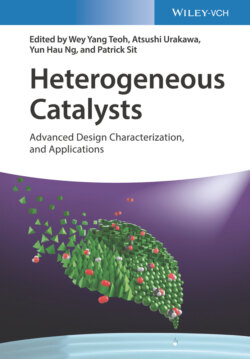Читать книгу Heterogeneous Catalysts - Группа авторов - Страница 10
Preface
ОглавлениеHeterogeneous catalyst to a chemical reaction is akin to a microscope to microbiology or a sail to a yacht. It is a necessary tool that helps to speed up reactions and at the same time steers the reactions in such a way that maximum selectivity of the desirable product can be attained. In that sense, heterogeneous catalysts will always be relevant as far as chemical reactions are of interest, whether at large industrial scales (e.g. commodity chemicals, petrochemical refineries), small scales (e.g. devices with catalytic functions such as automobile catalytic converters), or even microscales (e.g. microfluidic devices, catalytic nanomachines). The dedication of scientists and engineers working in the field of heterogeneous catalysis throughout the twentieth century was instrumental in solving of some of the most important problems facing humanity, including the nitrogen food chain issue (the so‐called Nitrogen problem), production of high‐quality automobile fuels (e.g. gasoline and diesel), abatement of noxious airborne pollutants, and the manufacturing of methanol as well as other building block chemicals.
Entering the twenty‐first century, the two immediate and overarching challenges in heterogeneous catalysis are (i) to address the issues related to global warming and climate change and (ii) to align with the United Nations sustainable development goals. Catalytic reactions such as water splitting, reduction of carbon dioxide, waste biomass conversion, removal of emerging aqueous micropollutants, and the abatement of NOx that are focused on enhancing renewable energy security and environmental sustainability will take the center stage against a backdrop of swelling population and increasing urbanization.
In adapting to these grand challenges, new and sophisticated emerging techniques in heterogeneous catalysis are continuously being developed to overcome the various limitations in catalyst design and to understand the mechanism of the molecular reactions occurring on the catalytic surface (information that can feed back to the catalyst design). At the same time, catalysts with different modes of activation are increasingly being appreciated, which besides the conventional thermal catalysts now include electrocatalysts and photocatalysts and their underlying physics. For newcomers entering the field, acquiring such vast amount of knowledge, although essential, can be overwhelming. That is not to mention the tenacity in mastering the basic fundamentals in heterogeneous catalysis, itself a century worth of knowledge, prior to the appreciation of these state‐of‐the‐art advancements. With this in hindsight, the book is geared toward attracting and assisting beginners who wish for a head start and quick overview on some of the most important emerging tools for catalyst design, techniques for operando/in situ characterization and ab initio computation, as well as a glimpse of the advancements in heterogeneous catalysis toward some of the grand challenges. Undergraduates with some prior exposure to reaction engineering/heterogeneous catalysis and analytical chemistry/spectroscopy or early postgraduates pursuing research on heterogeneous catalysis but only with some primitive background of the field shall find the book useful. Because the aim is to bridge the gap between amateur readers and expert knowledge, each chapter provides a brief description of the required basic fundamentals that lead to the appreciation of state‐of‐the‐art advancements.
It should be mentioned that the Contributors of the different chapters in the book are themselves among the most promising Emerging and Pioneering Researchers in the field of heterogeneous catalysis. We capitalized on that point in our book design to allow each Contributor to articulate the advancement of his/her own technique in a semitutorial manner that can be appreciated by the target readers. We strive to preserve a delicate balance between readability and articulating the complexity of the advanced techniques. In that sense, we present the content in a less mathematical (in a semiquantitative form, as much as we could) but comprehensible setting as the first step to inculcate interest and inspiration among beginners. With some patience, self‐learning is highly possible, following which readers should have the ability to pursue more quantitative references of specific techniques. With the heightened expectation of “cross skills” among the new generation of catalyst researchers, this book shall come in handy for readers to gain appreciation on some of the most advanced techniques before deciding to specialize in some of them. In fact, we hope that the book would serve as a platform to inspire readers to potentially develop their own original or hybrid techniques in a wider effort to tackling the grand challenges using heterogeneous catalysts.
Finally, we take the opportunity to thank Emerging and Pioneering Researchers who have contributed to this book, its vision and purpose. It has been a massive effort that took us more than three years to put together this book, and we thank the Contributors for their patience.
Wey Yang Teoh
University of Malaya, Malaysia
23 November 2020
Atsushi Urakawa
Delft University of Technology, The Netherlands
23 November 2020
Yun Hau Ng
City University of Hong Kong, S.A.R.
23 November 2020
Patrick Sit
City University of Hong Kong, S.A.R.
23 November 2020
